Blog Tour: Lesley Downer Talks About Writing Her Novel, The Shogun’s Queen
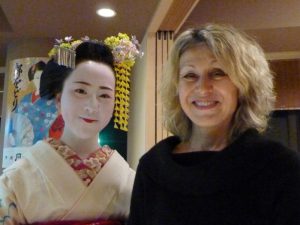
Me in Japan with a maiko (trainee geisha)
A big welcome today to Lesley Downer and the blog tour for her latest novel, The Shogun’s Queen which was released by Bantam Press on 3rd November.
Japan, and the year is 1853. Growing up among the samurai of the Satsuma Clan, in Japan’s deep south, the fiery, beautiful and headstrong Okatsu has – like all the clan’s women – been encouraged to be bold, taught to wield the halberd, and to ride a horse.
But when she is just seventeen, four black ships appear. Bristling with cannon and manned by strangers who to the Japanese eyes are barbarians, their appearance threatens Japan’s very existence. And turns Okatsu’s world upside down.
Today, on the last day of the tour, Lesley has joined me to talk about writing The Shogun’s Queen. Over to you, Lesley…
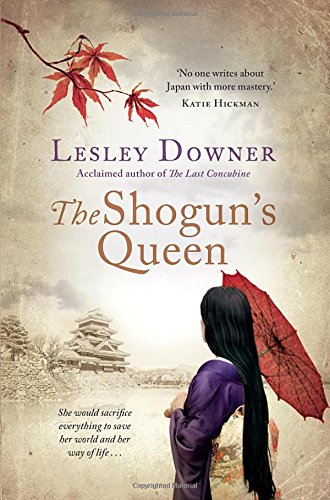 Hello, Laura. Thank you for allowing me to post on your blog today! I greatly appreciate it.
Hello, Laura. Thank you for allowing me to post on your blog today! I greatly appreciate it.
I’ve had a love affair with Japan all my life, and when I decided to move from non-fiction to fiction ten years ago, it was obvious that was where my stories would be set. I’m also mad about research. I love any excuse to go to Japan and I also love scouring old books written by Victorian travellers who were there in the nineteenth century. If I could live my life again it would be in old Japan, the Japan of the great woodblock print artists Hokusai and Hiroshige – and a reasonable second best is reading about it and being there in my mind and taking my readers there as I write about it.
Somehow – I forget how – I came across the Women’s Palace, a sort of harem where three thousand women lived and only one man, the shogun (the military ruler of Japan), could enter. To me the most surprising thing was that I’d spent so long in Japan and read so much about it yet in all those years hadn’t come across the Women’s Palace before. I decided to set my first novel there and so The Last Concubine was born. There was literally nothing in English about the palace. I had to struggle through a book written in Victorian-era Japanese with the help of a Japanese friend. My story took place at the very end of the era of the shoguns and my heroine fled the palace early on in the book.
I went on to write two more novels following on in time after the events of The Last Concubine.
Somewhere along the way I heard of Atsu’s heart-rending story and couldn’t get it out of my mind. It haunted me. Telling her story would mean going back to the Women’s Palace and I’d been feeling for a long time that I hadn’t finished with it – or rather it hadn’t finished with me.
By now there’d been a burgeoning of interest in the Women’s Palace. A couple of very scholarly books had come out in English and there’d also been a long series on Japanese TV set there.
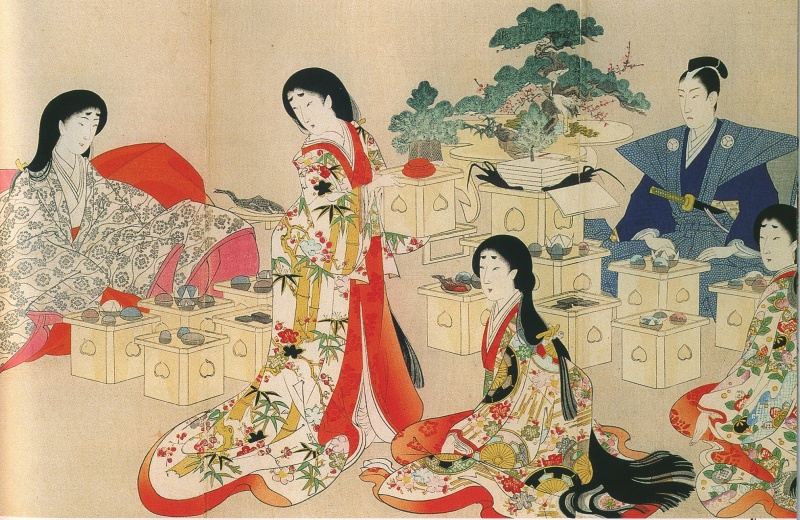
Long black hair of the women of the Women’s Palace (by Chikanobu Toyohara: Chiyoda No Ooku triptych)
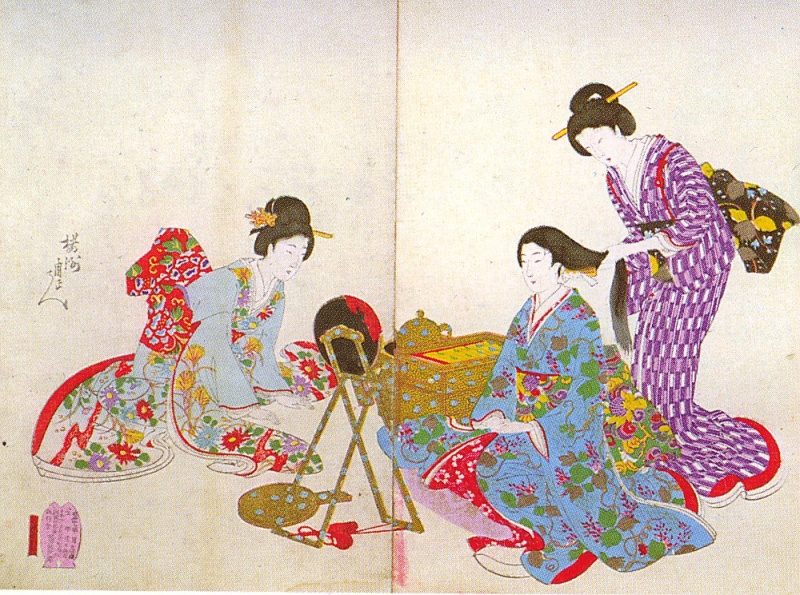
Ladies at their toilette (by Hashimoto Shuen: Chiyoda No Ooku)
Telling Atsu’s story would mean moving backwards in time, writing a prequel. But as I thought about it I realised that she was an extraordinary woman whose story needed to be told and that her years, the 1850s, were the key to all the stories I’d been telling in my previous novels. I’d thought I was writing a trilogy but it turned out it was a quartet – The Shogun Quartet.
And so I plunged back into extraordinary world. A large part of my book, I realised, would take place inside the Women’s Palace, so I started off by immersing myself in all the materials I could find about what life there had been like – the luxury, the kimonos, the gorgeous gardens, the intrigue, the plotting, the murders, the babies who were killed to make sure that your child and no one else’s would be the next shogun … There were dark depths to be plumbed.
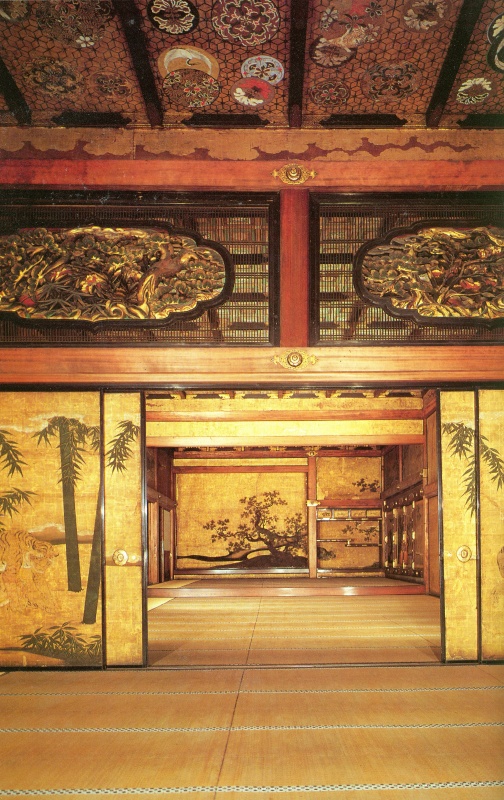
Lavish gold leaf covered walls (actually in Nijo Caslte, Kyoto)
It was also the perfect excuse to make yet another trip to Japan. I had myself buried in the hot black sands of Ibusuki, the idyllic seaside resort where Atsu had grown up, and followed her path from the deep south of Japan to Kyoto, which in her day was the emperor’s capital, and on to Edo, which we now call Tokyo. I knew there wasn’t much left of the real Women’s Palace so to help me imagine its glories I went to as many old castles and palaces as I could and lingered in the women’s quarters there and admired the lavish gold-leaf covered walls and elegant tatami mats.
Once I got home I put finger to laptop. No matter how much thinking I do and how many notes I make, it’s only when I put pencil to paper or finger to laptop that the creative flow begins.
Sitting down to write the first sentence was as always really hard. I try this and try that and what began as a paragraph in the middle often ends up as the first sentence.
At first I planned to set the whole story inside the Women’s Palace and tell the events that led up to Atsu’s arrival there in flashback. I wanted to evoke that claustrophobic atmosphere, take you inside the palace and never come out. I put several chapters on paper from that starting point.
But then I went on holiday and while I was away thoughts came bubbling up and I realised I needed to start earlier on. The story of Atsu’s early years was so crucial that without it the book would lose a lot. So I started all over again.
To me the key emotional impulse is Atsu’s love for Kaneshigé, this beautiful golden boy that she’s grown up with.
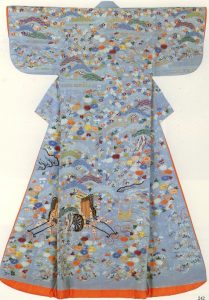
Gorgeous kimono worn by women of the Women’s Palace
Her life is perfect and then suddenly it falls apart. I also wanted to communicate how extraordinarily strong and feisty she was. And I wanted to show the dilemma that was part of Japanese society of that time and that tore her apart – between what you yourself desire and your duty, the things you have to do for the greater good. Modern people feel they are entitled to have whatever they want; but to the Japanese of that time duty and honour came before everything else.
I also decided to start with the arrival of the westerners in 1853 to force Japan to open its ports to western ships. It was the most dramatic event in the whole of Japanese history. It transformed Japan and sparked all the events of all four novels of my quartet. I tried to imagine how it must have felt to Japanese eyes, seeing these huge threatening alien ships looming on the horizon. That was documented too. It was like an alien invasion, like being attacked by Martians.
I also put in some chapters from the point of view of the westerners, dreaming up how the Japanese looked to the westerners and how the westerners looked to the Japanese.
I wrote the first draft then put it aside and thought about it for a while. Then I realised the whole thing needed to be seen through Atsu’s eyes; it’s her story. As always happens with the second draft, suddenly it all fell into place. I knew where the story was going now, I knew my characters much better. They were old friends now whereas at first they had been strangers.
Then finally I put the last full stop on the last page, took a deep breath and sent it off to my editor. The only question left was the title. I finally settled on The Shogun’s Queen.
 My verdict on The Shogun’s Queen:
My verdict on The Shogun’s Queen:
Atsu is from a small county town in Japan. When barbarians arrive from the west, she is removed from her home and away from the love of her life. She is adopted by her uncle with whom she travels with to Edo where she is further adopted again.
This time, she rises high enough in the ranks to join the women’s palace of the Shogun as his consort. Theirs is not an easy marriage though and the task her uncle has set for her seems impossible.
This book is based around a a very interesting history and one I will be researching further. It is obvious that Lesley has a lot of knowledge about Japan and this time period – something that really enhances the plot and makes this novel all the more fascinating.
The style of writing really pulled me into the novel. It is so atmospheric and I really felt as though I was there with Atsu in 1853 when Japan was going this huge change.
Straight away, you can tell that Atsu is a very strong yet sympathetic character. Her story really did give me an idea of what it must have been like for women in Japan at that time. To begin with, Atsu is made to believe that what she is trying to do is important so she makes the sacrifices she needs to in order to obey her uncle’s wishes. It becomes very evident though that women were simply just commodities – currency used by men to further their own rank and gain more power and were surplus to requirements.
The one thing I just struggle with (and this is simply me being daft) was keeping up with who everyone was (especially at the beginning.) To start with, I did worry it was going to distract me from the novel but this was not the case and  Lesley has included a character list at the start of the novel which was very helpful. It was something I had to consult less and less as I proceeded through the novel.
Lesley has included a character list at the start of the novel which was very helpful. It was something I had to consult less and less as I proceeded through the novel.
This novel is the fourth novel in the Shogun Quartet but is a prequel to the previous novels. It is beautifully written and I will certainly be checking out the others in the series.
If you’re a fan of Japan and its history or you love historical novels, this book is perfect for you.
 About Lesley:
About Lesley:
Lesley Downer’s mother was Chinese and her father a professor of Chinese. She ended up almost by accident in Japan and became fascinated by the country and its culture and people. It has been an ongoing love affair.
She is the author of The Shogun Quartet, a series of four historical novels set in Japan, beginning with the best-selling The Last Concubine, shortlisted for Romantic Novel of the Year and translated into thirty languages. The Shogun’s Queen, out now in most UK bookshops, is a prequel and the last in the series. Her non-fiction includes Geisha: The Secret History of a Vanishing World and Madame Sadayakko: The Geisha who Seduced the West.
For more information about Lesley, visit www.lesleydowner.com
Or you can follow her on Twitter: @LesleyDowner and on Facebook: Lesley Downer



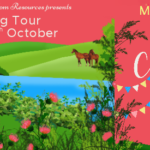

Leave a Reply